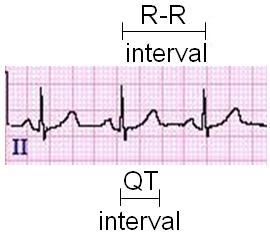ECG Basics
QT Interval
The QT interval is the time from the beginning of the QRS complex, representing ventricular depolarization, to the end of the T wave, resulting from ventricular repolarization.
The normal QT interval is controversial, and multiple normal durations have been reported. In general, the normal QT interval is below 400 to 440 milliseconds (ms), or 0.4 to 0.44 seconds. Women have a longer QT interval than men. Lower heart rates also result in a longer QT interval.
A quick way to distinguish a prolonged QT interval is to examine if the T wave ends beyond the halfway point between the RR interval. If the T wave ends past the halfway point of the RR interval, it is prolonged.
Due to the effects of heart rate, the corrected QT interval (QTc) is frequently used. The QTc is considered prolonged if greater than 450 ms in males and 470 ms in females. It is calculated using Bezett’s formula, described below.
Prolongation of the QT interval can result from multiple medications, electrolyte abnormalities — hypocalcemia, hypomagnesemia and hypokalemia — and certain disease states including intracranial hemorrhage.


